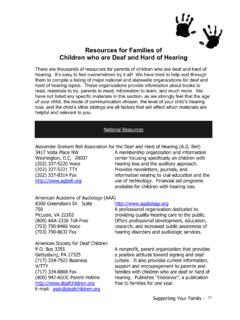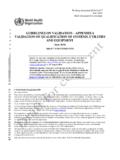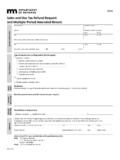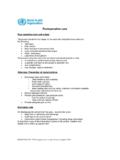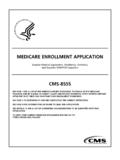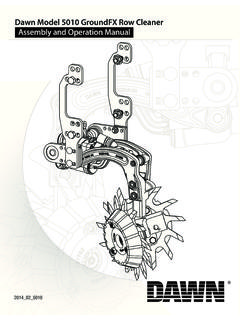Transcription of This technical assistance document was adapted …
1 This technical assistance document was adapted from the PBIS technical Brief on Classroom PBIS Strategies written by: Brandi Simonsen, Jennifer Freeman, Steve Goodman, Barbara Mitchell, Jessica Swain-Bradway, Brigid Flannery, George Sugai, Heather George, and Bob Putman, 2015. Additional assistance was provided to the Office of Special Education Programs by Brandi Simonsen and Jenifer Freeman. Special thanks to Allison Blakely, Ambra Green, and Jennifer Rink, OSEP interns who also contributed to the development of this document . 1 | P a g e Purpose and Description What is the purpose of this document ? The purpose of this document is to summarize evidence-based, positive, proactive, and responsive classroom behavior intervention and support strategies for teachers. These strategies should be used classroom-wide, intensified for support small-group instruction, or amplified further for individual students.
2 These strategies can help teachers capitalize on instructional time and decrease disruptions, which is crucial as schools are held to greater academic and social accountability measures for all students. What needs to be in place before I can expect these strategies to work? The effectiveness of these classroom strategies are maximized when: (a) the strategies are implemented within a school-wide multi-tiered behavioral framework, such as school-wide positive behavioral interventions and supports (PBIS; see ); (b) classroom and school-wide expectations and systems are directly linked; (c) classroom strategies are merged with effective instructional design, curriculum, and delivery; and (d) classroom-based data are used to guide decision making. The following school- and classroom-level supports should be in place to optimize the fidelity and benefits of implementation.
3 School-level supports Classroom-level supports A multi-tiered framework, including strategies for identifying and teaching expectations, acknowledging appropriate behavior, and responding to inappropriate behavior The school-wide framework is guided by school-wide discipline data Appropriate supports for staff are provided, including leadership teaming, supporting policy, coaching, and implementation monitoring Classroom system for teaching expectations, providing acknowledgments, and managing rule violations linked to the school-wide framework Classroom management decisions are based on classroom behavioral data Effective instructional strategies implemented to the greatest extent possible Curriculum is matched to student need and supporting data 2 | P a g e What are the principles that guide the use of these strategies in the classroom?
4 The purpose of the guiding principles is to define the characteristics and cultural features that drive the use of these classroom strategies within a multi-tiered framework. The guiding principles help establish the fundamental norms, rules, and ethics that are essential to the success of these classroom strategies within a multi-tiered framework. These seven principles are the foundational values that drive the success of these classroom strategies and are important to keep in mind when developing contextually appropriate adaptations of the strategies suggested in this document . Professional Business-like, objective, neutral, impartial, and unbiased Cultural Considerate of individual s learning history and experience s ( , family, community, peer group) Informed Data-based, response-to-intervention Fidelity-Based Implementation accuracy is monitored and adjusted as needed Educational The quality of design and delivery of instruction is considered Instructive Expected behaviors are explicitly taught, modeled, monitored, and reinforced Preventive Environment arranged to encourage previously taught social skills and discourage anticipated behavior errors User Guide What is included in this guide?
5 There are three main parts to this guide on classroom PBIS strategies. 1. Interactive map with corresponding tables, tools, and tips. The interactive map provides the links to the document with the content to support the implementation of the essential features of these classroom strategies. 2. Self-assessment and decision-making chart. These tools are intended to help guide the user to the parts of the document that will be most useful. 3. Scenarios. Two scenarios are provided to extend learning and provide concrete examples of how to use classroom PBIS strategies and many of the tools suggested in this document in consortium. A short summary and references are provided at the conclusion of the document . 3 | P a g e What is not included in this guide? This guide should not be considered a replacement for more comprehensive trainings and does not provide the depth of knowledge/research about each topic.
6 Although many of the strategies suggested in this document can be used for individual students, more support likely will be needed from a behavior specialist or school psychologist for teachers who work with students with more intensive support needs. This document also does not include strategies for addressing violent or unlawful student conduct. Where do I start? The interactive map provides an organizational layout of the document and some basic definitions of terms that may be helpful to know prior to taking the self-assessment. Teachers should begin with the self-assessment to gauge current classroom management practices. The self-assessment is designed to help teachers know where to focus their attention ( , foundations, practices, data systems). After teachers take the self-assessment, the interactive map will direct them to content that will be most useful.
7 The decision-making flow chart should be used to help guide teachers in making decisions about making adjustments within their classrooms. 4 | P a g e Interactive Map of Core Features Settings The physical layout of the classroom is designed to be effective Expectations Three to five classroom rules are clearly posted, defined, and explicitly taught Routines Predictable classroom routines are developed and taught Supervision Provide reminders (prompts), and actively scan, move, and interact with students Opportunity Provide high rates and varied opportunities for all students to respond Acknowledgment Using specific praise and other strategies, let students know when they meet classroom expectations Prompts and Precorrections Provide reminders, before a behavior is expected, that clearly describe the expectation Error Corrections Use brief, contingent, and specific statements when misbehavior occurs Other Strategies Use other strategies that preempt escalation, minimize inadvertent reward of the problem behavior, create a learning opportunity for emphasizing desired behavior, and maintain optimal instructional time Additional Tools More tips for teachers Classroom Interventions and Supports Foundations (Table 1) Response Prevention Data Systems (Table 3) Practices (Table 2)
8 Counting Record how often or how many times a behavior occurs (also called frequency) Timing Record how long a behavior lasts (also called duration). Sampling Estimate how often a behavior occurs during part of an interval, the entire interval, or at the end of an interval ABC Cards, Incident Reports, or Office Discipline Referrals Record information about the events that occurred before, during, and after a behavior incident 5 | P a g e Self-Assessment Teachers should start with the first statement on the self-assessment. When unsure of an answer, teachers should go to the part of the interactive map indicated and read more about the practice. Classroom Interventions and Supports Self-Assessment Yes No 1. The classroom is physically designed to meet the needs of all students. If yes, continue with self-assessment. If no, begin with on the interactive map.
9 2. Classroom routines are developed, taught, and predictable. If yes, continue with self-assessment. If no, begin with on the interactive map. 3. Three to five positive classroom expectations are posted, defined, and explicitly taught. If yes, continue with self-assessment. If no, begin with on the interactive map. 4. Prompts and active supervision practices are used proactively. If yes, continue with self-assessment. If no, begin with on the interactive map. 5. Opportunities to respond are varied and are provided at high rates. If yes, continue with self-assessment. If no, begin with on the interactive map. 6. Specific praise and other strategies are used to acknowledge behavior. If yes, continue with self-assessment. If no, begin with on the interactive map. 7. Reminders are consistently given before a behavior might occur. If yes, continue with self-assessment.
10 If no, begin with on the interactive map. 8. The responses to misbehaviors in the classroom are appropriate and systematic. If yes, continue with self-assessment. If no, begin with on the interactive map. 9. Data systems are used to collect information about classroom behavior. If yes, continue with self-assessment. If no, begin with Table 3 on the interactive map. If yes on all, celebrate successes! Continually monitor, and make adjustments as needed. 6 | P a g e Decision-Making Chart The decision-making chart will help guide teachers regarding implementation of best practices in preventing and responding to behaviors in the classroom. 7 | P a g e Table 1. Matrix of Foundations for Classroom Interventions and Supports SETTINGS EFFECTIVELY DESIGN THE PHYSICAL ENVIRONMENT OF THE CLASSROOM Description and Critical Features Elementary Examples Secondary Examples Non- Examples Empirical Support and Resources What key strategies can I use to support behavior in my classroom?

